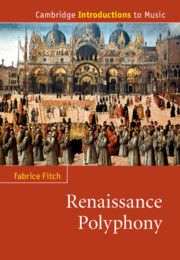Book contents
- Cambridge Introductions to Music
- Cambridge Introductions to Music Renaissance Polyphony
- Copyright page
- Dedication
- Contents
- Illustrations
- Figures
- Tables
- Music examples
- Acknowledgements
- Note on the music examples
- Note on the bibliography
- Abbreviations
- Chapter 1 Introducing Renaissance polyphony
- Chapter 2 Making polyphony: sources and practice
- Chapter 3 Makers of polyphony
- Chapter 4 Pitch: an overview
- Chapter 5 Voice-names, ranges, and functions
- Chapter 6 Mensural notation, duration, and metre
- Chapter 7 Genre, texts, forms
- Chapter 8 ‘Cantus magnus’: music for the Mass
- Chapter 9 ‘Cantus mediocris’: the motet
- Chapter 10 ‘Cantus parvus’: secular music
- Chapter 11 Scoring, texture, scale
- Chapter 12 Understanding musical borrowing
- Chapter 13 Canons, puzzles, games
- Chapter 14 Performance practice: a brief introduction
- Notes
- Glossary
- Bibliography
- Index of compositions
- General index
- Cambridge Introductions to Music
Chapter 6 - Mensural notation, duration, and metre
Published online by Cambridge University Press: 13 August 2020
- Cambridge Introductions to Music
- Cambridge Introductions to Music Renaissance Polyphony
- Copyright page
- Dedication
- Contents
- Illustrations
- Figures
- Tables
- Music examples
- Acknowledgements
- Note on the music examples
- Note on the bibliography
- Abbreviations
- Chapter 1 Introducing Renaissance polyphony
- Chapter 2 Making polyphony: sources and practice
- Chapter 3 Makers of polyphony
- Chapter 4 Pitch: an overview
- Chapter 5 Voice-names, ranges, and functions
- Chapter 6 Mensural notation, duration, and metre
- Chapter 7 Genre, texts, forms
- Chapter 8 ‘Cantus magnus’: music for the Mass
- Chapter 9 ‘Cantus mediocris’: the motet
- Chapter 10 ‘Cantus parvus’: secular music
- Chapter 11 Scoring, texture, scale
- Chapter 12 Understanding musical borrowing
- Chapter 13 Canons, puzzles, games
- Chapter 14 Performance practice: a brief introduction
- Notes
- Glossary
- Bibliography
- Index of compositions
- General index
- Cambridge Introductions to Music
Summary
This chapter introduces mensural notation and shows how changes of practice affect musical style during the Renaissance, mirroring the approach in the previous chapters in the domain of pitch. Here again, two crucial changes are observable, roughly contemporary with those observed in Chapter 5: the first is the gradual abandonment of major prolation (c. 1440) as the predominant mensuration in favour of perfect tempus, and the alternation of tempus perfectum and tempus imperfectum (with minor prolation) as a structural feature in larger-scale works; the second is the adoption of tempus imperfectum as the standard mensural sign during the final quarter of the fifteenth century, after which the notational subtleties associated with the system of ‘four prolations’ gradually fell out of use. But this chapter also demonstrates the great elegance of the mensural system, showing its flexibility and economical presentation of situations of considerable rhythmic intricacy, which has an aesthetic quality all of its own. In many cases, the conception of the individual work is grounded as much in its notation as in the sounding result.
- Type
- Chapter
- Information
- Renaissance Polyphony , pp. 83 - 95Publisher: Cambridge University PressPrint publication year: 2020

